UPLC-MS/MS Analysis of Naturally Derived Apis mellifera Products and Their Promising Effects against Cadmium-Induced Adverse Effects in Female Rats
Abstract
1. Introduction
2. Materials and Methods
2.1. Chemicals
2.2. Analysis of the Samples Using LTQ-UPLC-MS/MS
2.3. Animals
2.4. Experimental Outline
2.5. Sampling and Reproductive Organ Collection
2.6. Energy Dispersive X-ray (EDX) Measurement
2.7. Electron Microscope Examination
2.8. Biochemical Analyses
2.8.1. Thiobarbituric Acid Reactive Substances (TBARS)
2.8.2. Inflammatory Parameter
2.8.3. Antioxidant Parameters
2.9. Evaluation of Estrus Cycle
2.10. Statistical Procedures
3. Results
3.1. Linear Ion Trap-Ultra-Performance Liquid Chromatography-Mass Spectrometry Analysis
3.2. Body Weight of Animals
3.3. Assessment of the Impact of RJ and P upon Cd Accumulation in the Testicular and Ovarian Tissues
3.4. Histopathological and Ultrastructure Changes in the Ovarian Tissue
3.5. Evaluation of the Effect of P and RJ on Cd-Induced Oxidative Stress and Antioxidant Enzyme Activity in the Ovarian Tissues
3.6. Assessment of the Estrus Cycle Length in the Different Treated Females
4. Discussion
5. Conclusions
Author Contributions
Funding
Institutional Review Board Statement
Informed Consent Statement
Data Availability Statement
Acknowledgments
Conflicts of Interest
References
- Yosri, N.; El-Wahed, A.A.A.; Ghonaim, R.; Khattab, O.M.; Sabry, A.; Ibrahim, M.A.A.; Moustafa, M.F.; Guo, Z.; Zou, X.; Algethami, A.F.M.; et al. Anti-viral and immunomodulatory properties of propolis: Chemical diversity, pharmacological properties, preclinical and clinical applications, and in silico potential against SARS-CoV-2. Foods 2021, 10, 1776. [Google Scholar] [CrossRef]
- Salama, S.; Shou, Q.; Abd El-Wahed, A.A.; Elias, N.; Xiao, J.; Swillam, A.; Umair, M.; Guo, Z.; Daglia, M.; Wang, K.; et al. Royal jelly: Beneficial properties and synergistic effects with chemotherapeutic drugs with particular emphasis in anticancer strategies. Nutrients 2022, 14, 4166. [Google Scholar] [CrossRef]
- Noh, S.; Go, A.; Kim, D.B.; Park, M.; Jeon, H.W.; Kim, B. Role of antioxidant natural products in management of infertility: A review of their medicinal potential. Antioxidants 2020, 9, 957. [Google Scholar] [CrossRef]
- Pasupuleti, V.R.; Sammugam, L.; Ramesh, N.; Gan, S.H. Honey, propolis, and royal jelly: A comprehensive review of their biological actions and health benefits. Oxid. Med. Cell. Longev. 2017, 2017, 1259510. [Google Scholar] [CrossRef]
- Fujita, T.; Kozuka-Hata, H.; Ao-Kondo, H.; Kunieda, T.; Oyama, M.; Kubo, T. Proteomic analysis of the royal jelly and characterization of the functions of its derivation glands in the honeybee. J. Proteome Res. 2013, 12, 404–411. [Google Scholar] [CrossRef]
- Sharif, S.N.; Darsareh, F. Effect of royal jelly on menopausal symptoms: A randomized placebo-controlled clinical trial. Complement. Ther. Clin. Pract. 2019, 37, 47–50. [Google Scholar] [CrossRef]
- Hamid, N.A.; Bakar, A.B.A.; Zain, A.A.M.; Hussain, N.H.N.; Othman, Z.A.; Zakaria, Z.; Mohamed, M. Composition of Royal Jelly (RJ) and its anti-androgenic effect on reproductive parameters in a polycystic ovarian syndrome (PCOS) animal model. Antioxidants 2020, 9, 499. [Google Scholar] [CrossRef]
- Kridli, R.T.; Husein, M.Q.; Humphrey, W.D. Effect of royal jelly and GnRH on the estrus synchronization and pregnancy rate in ewes using intravaginal sponges. Small Rumin. Res. 2003, 49, 25–30. [Google Scholar] [CrossRef]
- El-Hanoun, A.M.; Elkomy, A.E.; Fares, W.A.; Shahien, E.H. Impact of royal jelly to improve reproductive performance of male rabits under hot sumer conditions. World Rabbit Sci. 2014, 22, 241–248. [Google Scholar] [CrossRef]
- Kunugi, H.; Ali, A.M. Royal jelly and its components promote healthy aging and longevity: From animal models to humans. Int. J. Mol. Sci. 2019, 20, 4662. [Google Scholar] [CrossRef]
- Abdelhafiz, A.T.; Muhamad, J.A. Midcycle pericoital intravaginal bee honey and royal jelly for male factor infertility. Int. J. Gynecol. Obstet. 2008, 101, 146–149. [Google Scholar] [CrossRef] [PubMed]
- Šturm, L.; Ulrih, N.P. Advances in the propolis chemical composition between 2013 and 2018: A review. eFood 2019, 1, 24–37. [Google Scholar] [CrossRef]
- El-ratel, I.T.; El-moghazy, M.M. Effects of propolis ethanolic extract administration on quality of fresh and cryopreserved semen, redox status, and sperm flow cytometry parameters of heat-stressed rabbit bucks. Adv. Anim. Vet. Sci. 2022, 10, 2578–2589. [Google Scholar] [CrossRef]
- Kumari, S.; Nayak, G.; Lukose, S.T.; Kalthur, S.G.; Bhat, N.; Hegde, A.R.; Mutalik, S.; Kalthur, G.; Adiga, S.K. Indian propolis ameliorates the mitomycin C-induced testicular toxicity by reducing DNA damage and elevating the antioxidant activity. Biomed. Pharmacother. 2017, 95, 252–263. [Google Scholar] [CrossRef]
- Handayani, N.; Gofur, A. Does propolis extract alleviate male reproductive performance through gonadotropic hormone levels and sperm quality? IOP Conf. Ser. Earth Environ. Sci. 2019, 276, 12056–12062. [Google Scholar] [CrossRef]
- World Health Organization (WHO). International Classification of Diseases, 11th Revision (ICD-11) Geneva; WHO: Geneva, Switzerland, 2018.
- Liu, X.X.; Wang, Z.X.; Liu, F.J. Chronic exposure of BPA impairs male germ cell proliferation and induces lower sperm quality in male mice. Chemosphere 2021, 262, 127880–127888. [Google Scholar] [CrossRef]
- Tang, L.; Rodriguez-Sosa, J.R.; Dobrinski, I. Germ cell transplantation and testis tissue xenografting in mice. J. Vis. Exp. 2012, 60, e3545. [Google Scholar] [CrossRef]
- Centres for Disease Control and Prevention National Center for Health Statistics—Infertility Statistics. 2016. Available online: https://www.cdc.gov/nchs/fastats/infertility.htm (accessed on 6 December 2022).
- Bui, A.H.; Timmons, D.B.; Young, S.L. Evaluation of endometrial receptivity and implantation failure. Curr. Opin. Obstet. Gynecol. 2022, 34, 107–113. [Google Scholar] [CrossRef]
- Innocenti, F.; Cerquetti, L.; Pezzilli, S.; Bucci, B.; Toscano, V.; Canipari, R.; Stigliano, A. Effect of mitotane on mouse ovarian follicle development and fertility. J. Endocrinol. 2017, 234, 29–39. [Google Scholar] [CrossRef]
- Zamberlam, G.; Lapointe, E.; Abedini, A.; Rico, C.; Godin, P.; Paquet, M.; Demayo, F.J.; Boerboom, D. SFRP4 Is a negative regulator of ovarian follicle development and female fertility. Endocrinology 2019, 160, 1561–1572. [Google Scholar] [CrossRef]
- Adeoye, O.; Olawumi, J.; Opeyemi, A.; Christiania, O. Review on the role of glutathione on oxidative stress and infertility. J. Bras. Reprod. Assist. 2018, 22, 61–66. [Google Scholar] [CrossRef] [PubMed]
- Guo, H.; Ouyang, Y.; Yin, H.; Cui, H.; Deng, H.; Liu, H.; Jian, Z.; Fang, J.; Zuo, Z.; Wang, X.; et al. Induction of autophagy via the ROS-dependent AMPK-mTOR pathway protects copper-induced spermatogenesis disorder. Redox Biol. 2022, 49, 102227–102241. [Google Scholar] [CrossRef] [PubMed]
- Liu, Z.; Zhuan, Q.; Zhang, L.; Meng, L.; Fu, X.; Hou, Y. Polystyrene microplastics induced female reproductive toxicity in mice. J. Hazard. Mater. 2022, 424, 127629–127640. [Google Scholar] [CrossRef] [PubMed]
- Xie, X.; Deng, T.; Duan, J.; Xie, J.; Yuan, J.; Chen, M. Exposure to polystyrene microplastics causes reproductive toxicity through oxidative stress and activation of the p38 MAPK signaling pathway. Ecotoxicol. Environ. Saf. 2020, 190, 110133–110140. [Google Scholar] [CrossRef]
- Smits, R.M.; Mackenzie-Proctor, R.; Fleischer, K.; Showell, M.G. Antioxidants in fertility: Impact on male and female reproductive outcomes. Fertil. Steril. 2018, 110, 578–580. [Google Scholar] [CrossRef]
- Sukhn, C.; Awwad, J.; Ghantous, A.; Zaatari, G. Associations of semen quality with non-essential heavy metals in blood and seminal fluid: Data from the Environment and Male Infertility (EMI) study in Lebanon. J. Assist. Reprod. Genet. 2018, 35, 1691–1701. [Google Scholar] [CrossRef]
- Famurewa, A.C.; Ugwuja, E.I. Association of blood and seminal plasma cadmium and lead levels with semen quality in non-occupationally exposed infertile men in Abakaliki, South eEast Nigeria. J. Fam. Reprod. Health 2017, 11, 97–103. [Google Scholar]
- Madej, D.; Kaluza, J.; Pietruszka, B. The effect of iron and/or zinc diet supplementation and termination of this practice on the content of these elements in male rats’ reproductive tissues. J. Elem. 2019, 24, 559–574. [Google Scholar] [CrossRef]
- Agency for Toxic Substances and Disease Registry (ATSDR) Substance Priority List. Available online: https//www.atsdr.cdc.gov/spl/index.html. (accessed on 6 October 2022).
- Agency for Toxic Substances and Disease Registry (ATSDR), Cadmium Toxicological Profile. Available online: https://wwwn.cdc.gov/TSP/ToxProfiles/ToxProfiles.aspx?id=48&tid=15 (accessed on 6 October 2022).
- Satarug, S.; Garrett, S.H.; Sens, M.A.; Sens, D.A. Cadmium, environmental exposure, and health outcomes. Environ. Health Perspect. 2010, 118, 182–190. [Google Scholar] [CrossRef]
- Abosedera, D.A.; Emara, S.A.; Tamam, O.A.S.; Badr, O.M.; Khalifa, S.A.M.; El-Seedi, H.R.; Refaey, M.S. Metabolomic profile and in vitro evaluation of the cytotoxic activity of Asphodelus microcarpus against human malignant melanoma cells A375. Arab. J. Chem. 2022, 15, 104174–104187. [Google Scholar] [CrossRef]
- El-Garawani, I.; El-Nabi, S.H.; El Kattan, A.; Sallam, A.; Elballat, S.; Abou-Ghanima, S.; El Azab, I.H.; El-Seedi, H.R.; Khalifa, S.A.M.; El-Shamy, S. The ameliorative role of Acacia senegal gum against the oxidative stress and genotoxicity induced by the radiographic contrast medium (Ioxitalamate) in albino rats. Antioxidants 2021, 10, 221. [Google Scholar] [CrossRef] [PubMed]
- El-Din, M.I.G.; Fahmy, N.M.; Wu, F.; Salem, M.M.; Khattab, O.M.; El-Seedi, H.R.; Korinek, M.; Hwang, T.L.; Osman, A.K.; El-Shazly, M.; et al. Comparative LC–LTQ–MS–MS analysis of the leaf extracts of Lantana camara and Lantana montevidensis growing in Egypt with insights into their anti-Inflammatory, and cytotoxic activities. Plants 2022, 11, 1699. [Google Scholar] [CrossRef] [PubMed]
- Draper, H.H.; Hadley, M. Malondialdehyde determination as index of lipid Peroxidation. Methods Enzymol. 1990, 186, 421–431. [Google Scholar] [CrossRef] [PubMed]
- Rouhani, M. A detailed computational investigation on the structural and spectroscopic properties of propolisbenzofuran B. Heliyon 2019, 5, e02518. [Google Scholar] [CrossRef] [PubMed]
- Wang, M.; Carver, J.J.; Phelan, V.V.; Sanchez, L.M.; Garg, N.; Peng, Y.; Nguyen, D.D.; Watrous, J.; Kapono, C.A.; Luzzatto-Knaan, T. Sharing and community curation of mass spectrometry data with Global Natural Products Social Molecular Networking. Nat. Biotechnol. 2016, 34, 828–837. [Google Scholar] [CrossRef] [PubMed]
- Fontana, R.; Mendes, M.A.; de Souza, B.M.; Konno, K.; César, L.M.M.; Malaspina, O.; Palma, M.S. Jelleines: A family of antimicrobial peptides from the Royal Jelly of honeybees (Apis mellifera). Peptides 2004, 25, 919–928. [Google Scholar] [CrossRef] [PubMed]
- Corrêa, F.R.S.; Schanuel, F.S.; Moura-Nunes, N.; Monte-Alto-Costa, A.; Daleprane, J.B. Brazilian red propolis improves cutaneous wound healing suppressing inflammation-associated transcription factor NFκB. Biomed. Pharmacother. 2017, 86, 162–171. [Google Scholar] [CrossRef] [PubMed]
- Dudoit, A.; Mertz, C.; Chillet, M.; Cardinault, N.; Brat, P. Antifungal activity of Brazilian red propolis extract and isolation of bioactive fractions by thin-layer chromatography-bioautography. Food Chem. 2020, 327, 127060–127068. [Google Scholar] [CrossRef] [PubMed]
- Picolotto, A.; Pacheco, G.; Gomes, K.; Barud, S.; Roesch-ely, M.; Henrique, M.; Tasso, L. Bacterial cellulose membrane associated with red propolis as phytomodulator: Improved healing effects in experimental models of Diabetes mellitus. Biomed. Pharmacother. 2019, 112, 108640–108649. [Google Scholar] [CrossRef]
- Siheri, W.; Ebiloma, G.U.; Igoli, J.O.; Gray, A.I.; Biddau, M.; Akrachalanont, P.; Alenezi, S.; Alwashih, M.A.; Edrada-Ebel, R.A.; Muller, S.; et al. Isolation of a novel flavanonol and an alkylresorcinol with highly potent anti-trypanosomal activity from libyan propolis. Molecules 2019, 24, 1041. [Google Scholar] [CrossRef]
- Honda, Y.; Araki, Y.; Hata, T.; Ichihara, K.; Ito, M.; Tanaka, M.; Honda, S. 10-Hydroxy-2-decenoic acid, the major lipid component of royal jelly, extends the lifespan of Caenorhabditis elegans through dietary restriction and target of rapamycin signaling. J. Aging Res. 2015, 2015, 425261. [Google Scholar] [CrossRef] [PubMed]
- Ristivojević, P.; Trifković, J.; Gašić, U.; Andrić, F.; Nedić, N.; Tešić, Ž.; Milojković-Opsenica, D. Ultrahigh-performance Liquid Chromatography and Mass Spectrometry (UHPLC–LTQ/Orbitrap/MS/MS) study of phenolic profile of Serbian poplar type propolis. Phytochem. Anal. 2015, 26, 127–136. [Google Scholar] [CrossRef] [PubMed]
- Athikomkulchai, S.; Awale, S.; Ruangrungsi, N.; Ruchirawat, S.; Kadota, S. Chemical constituents of Thai propolis. Fitoterapia 2013, 88, 96–100. [Google Scholar] [CrossRef] [PubMed]
- Collazo, N.; Carpena, M.; Nuñez-Estevez, B.; Otero, P.; Simal-Gandara, J.; Prieto, M.A. Health promoting properties of bee royal jelly: Food of the queens. Nutrients 2021, 13, 543. [Google Scholar] [CrossRef]
- Mavri, A.; Abramovič, H.; Polak, T.; Bertoncelj, J.; Jamnik, P.; Smole Moažina, S.; Jeršek, B. Chemical properties and antioxidant and antimicrobial activities of slovenian propolis. Chem. Biodivers. 2012, 9, 1545–1558. [Google Scholar] [CrossRef]
- Sidor, E.; Miłek, M.; Zaguła, G.; Bocian, A.; Dżugan, M. Searching for differences in chemical composition and biological activity of crude drone brood and royal jelly useful for their authentication. Foods 2021, 10, 2233. [Google Scholar] [CrossRef]
- Kasote, D.; Bankova, V.; Viljoen, A.M. Propolis: Chemical diversity and challenges in quality control. Phytochem. Rev. 2022, 21, 1887–1911. [Google Scholar] [CrossRef]
- Sapmaz, T.; Sevgin, K.; Topkaraoglu, S.; Tekayev, M.; Gumuskaya, F.; Efendic, F.; Pence, M.E.; Aktas, S.; Hekimoglu, G.; Irkorucu, O. Propolis protects ovarian follicular reserve and maintains the ovary against polycystic ovary syndrome (PCOS) by attenuating degeneration of zona pellucida and fibrous tissue. Biochem. Biophys. Res. Commun. 2022, 636, 97–103. [Google Scholar] [CrossRef]
- Ghanbari, E.; Khazaei, M.R.; Khazaei, M.; Nejati, V. Royal jelly promotes ovarian follicles growth and increases steroid hormones in immature rats. Int. J. Fertil. Steril. 2018, 11, 263–269. [Google Scholar] [CrossRef]
- Kamal, D.A.M.; Salamt, N.; Zaid, S.S.M.; Mokhtar, M.H. Beneficial effects of green tea catechins on female reproductive disorders: A review. Molecules 2021, 26, 2675. [Google Scholar] [CrossRef]
- Grzesik, M.; Naparło, K.; Bartosz, G.; Sadowska-Bartosz, I. Antioxidant properties of catechins: Comparison with other antioxidants. Food Chem. 2018, 241, 480–492. [Google Scholar] [CrossRef] [PubMed]
- Yi, Y.Y.; Wan, S.X.; Hou, Y.X.; Cheng, J.; Guo, J.H.; Wang, S.; Khan, A.; Sun, N.; Li, H. Chlorogenic acid rescues zearalenone induced injury to mouse ovarian granulosa cells. Ecotoxicol. Environ. Saf. 2020, 194, 110401–110408. [Google Scholar] [CrossRef] [PubMed]
- Abedpour, N.; Javanmard, M.Z.; Karimipour, M.; Farjah, G.H. Chlorogenic acid improves functional potential of follicles in mouse whole ovarian tissues in vitro. Mol. Biol. Rep. 2022, 49, 10327–10338. [Google Scholar] [CrossRef] [PubMed]
- Wang, M.; Guckland, A.; Murfitt, R.; Ebeling, M.; Sprenger, D.; Foudoulakis, M.; Koutsaftis, A. Relationship between magnitude of body weight effects and exposure duration in mammalian toxicology studies and implications for ecotoxicological risk assessment. Environ. Sci. Eur. 2019, 31, 38–44. [Google Scholar] [CrossRef]
- Nwokocha, C.R.; Nwokocha, M.I.; Aneto, I.; Obi, J.; Udekweleze, D.C.; Olatunde, B.; Owu, D.U.; Iwuala, M.O. Comparative analysis on the effect of Lycopersicon esculentum (tomato) in reducing cadmium, mercury and lead accumulation in liver. Food Chem. Toxicol. 2012, 50, 2070–2073. [Google Scholar] [CrossRef]
- Yan, L.J.; Allen, D.C. Cadmium-induced kidney injury: Oxidative damage as a unifying mechanism. Biomolecules 2021, 11, 1575. [Google Scholar] [CrossRef]
- Godam, E.T.; Olaniyan, O.T.; Wofuru, C.D.; Orupabo, C.D.; Ordu, K.S.; Gbaranor, B.K.; Dakoru, P.D. Xylopia aethiopica ethanol seed extract suppresses cadmium chloride-induced ovary and gonadotropins toxicity in adult female wistar rats. J. Bras. Reprod. Assist. 2021, 25, 252–256. [Google Scholar] [CrossRef]
- Bergeron, P.M.; Jumarie, C. Reciprocal inhibition of Cd2+ and Ca2+ uptake in human intestinal crypt cells for voltage-independent Zn-activated pathways. Biochim. Biophys. Acta-Biomembr. 2006, 1758, 702–712. [Google Scholar] [CrossRef]
- Nna, V.U.; Usman, U.Z.; Ofutet, E.O.; Owu, D.U. Quercetin exerts preventive, ameliorative and prophylactic effects on cadmium chloride—Induced oxidative stress in the uterus and ovaries of female Wistar rats. Food Chem. Toxicol. 2017, 102, 143–155. [Google Scholar] [CrossRef]
- Nasiadek, M.; Danilewicz, M.; Klimczak, M.; Stragierowicz, J.; Kilanowicz, A. Subchronic exposure to cadmium causes persistent changes in the reproductive system in female wistar rats. Oxid. Med. Cell. Longev. 2019, 2019, 6490820. [Google Scholar] [CrossRef]
- Devine, P.J.; Perreault, S.D.; Luderer, U. Roles of reactive oxygen species and antioxidants in ovarian toxicity. Biol. Reprod. 2012, 86, 27. [Google Scholar] [CrossRef] [PubMed]
- Abudawood, M.; Tabassum, H.; Alanazi, A.H.; Almusallam, F.; Aljaser, F.; Ali, M.N.; Alenzi, N.D.; Alanazi, S.T.; Alghamdi, M.A.; Altoum, G.H.; et al. Antioxidant status in relation to heavy metals induced oxidative stress in patients with polycystic ovarian syndrome (PCOS). Sci. Rep. 2021, 11, 22935. [Google Scholar] [CrossRef] [PubMed]
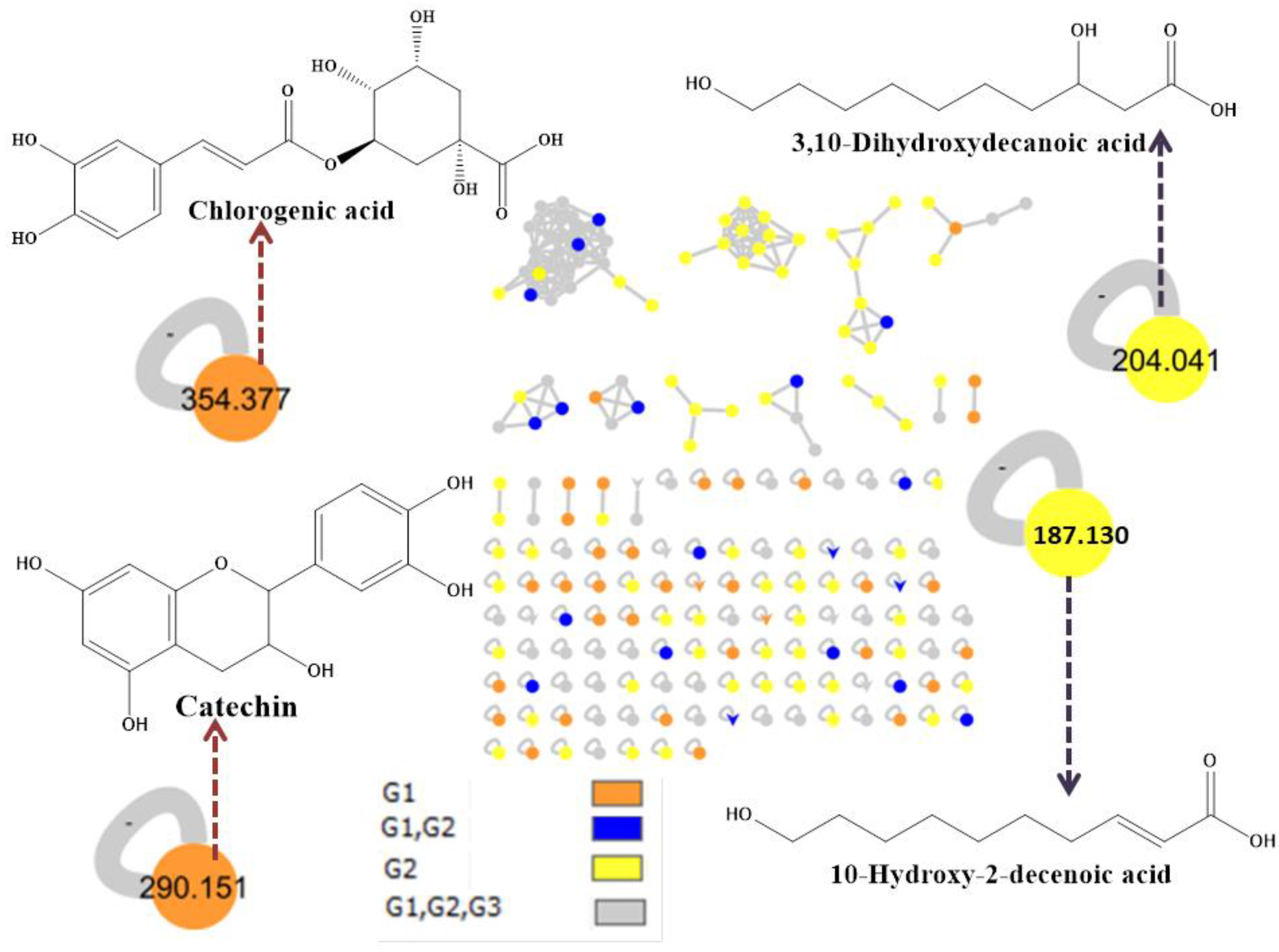
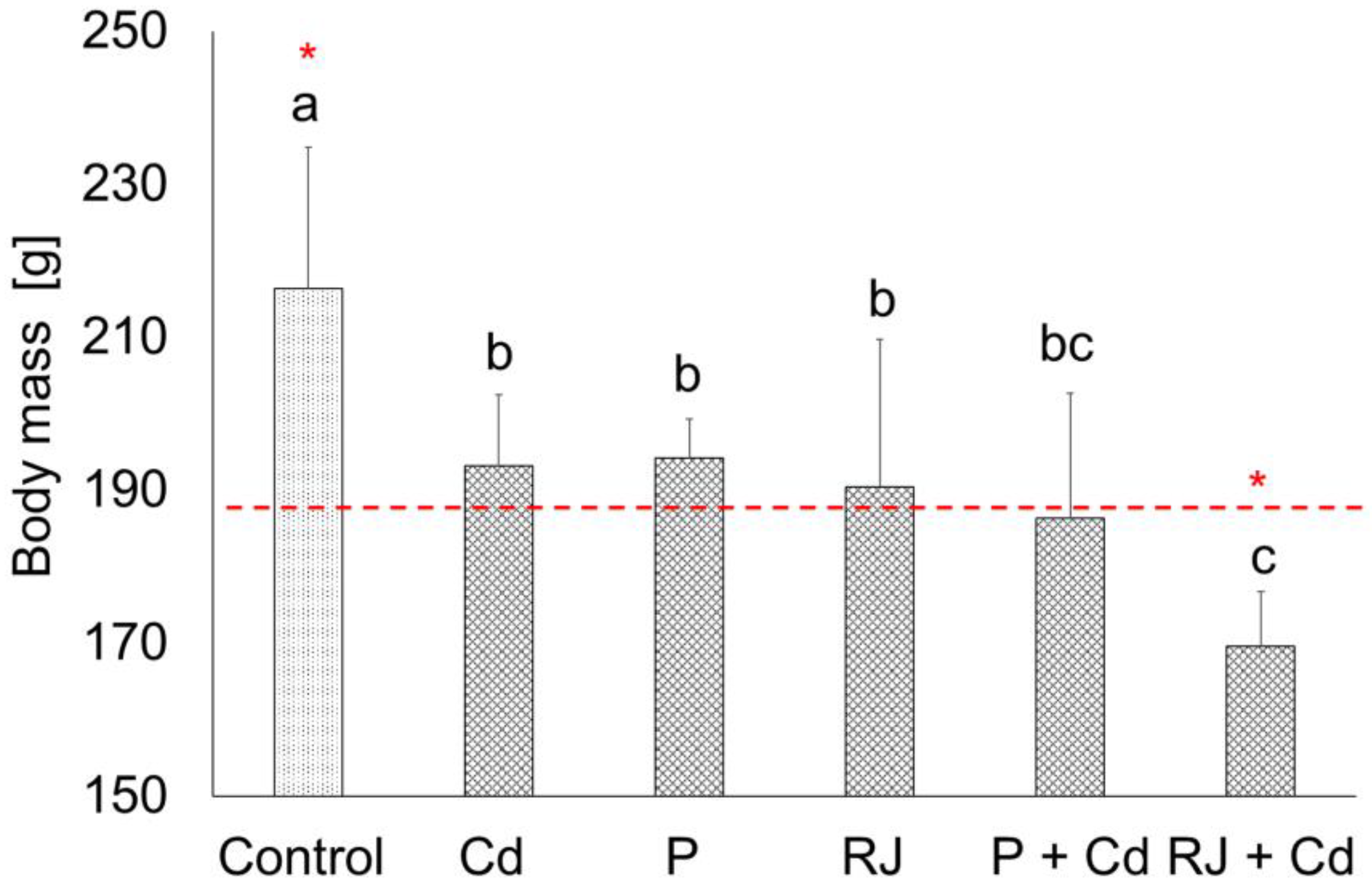
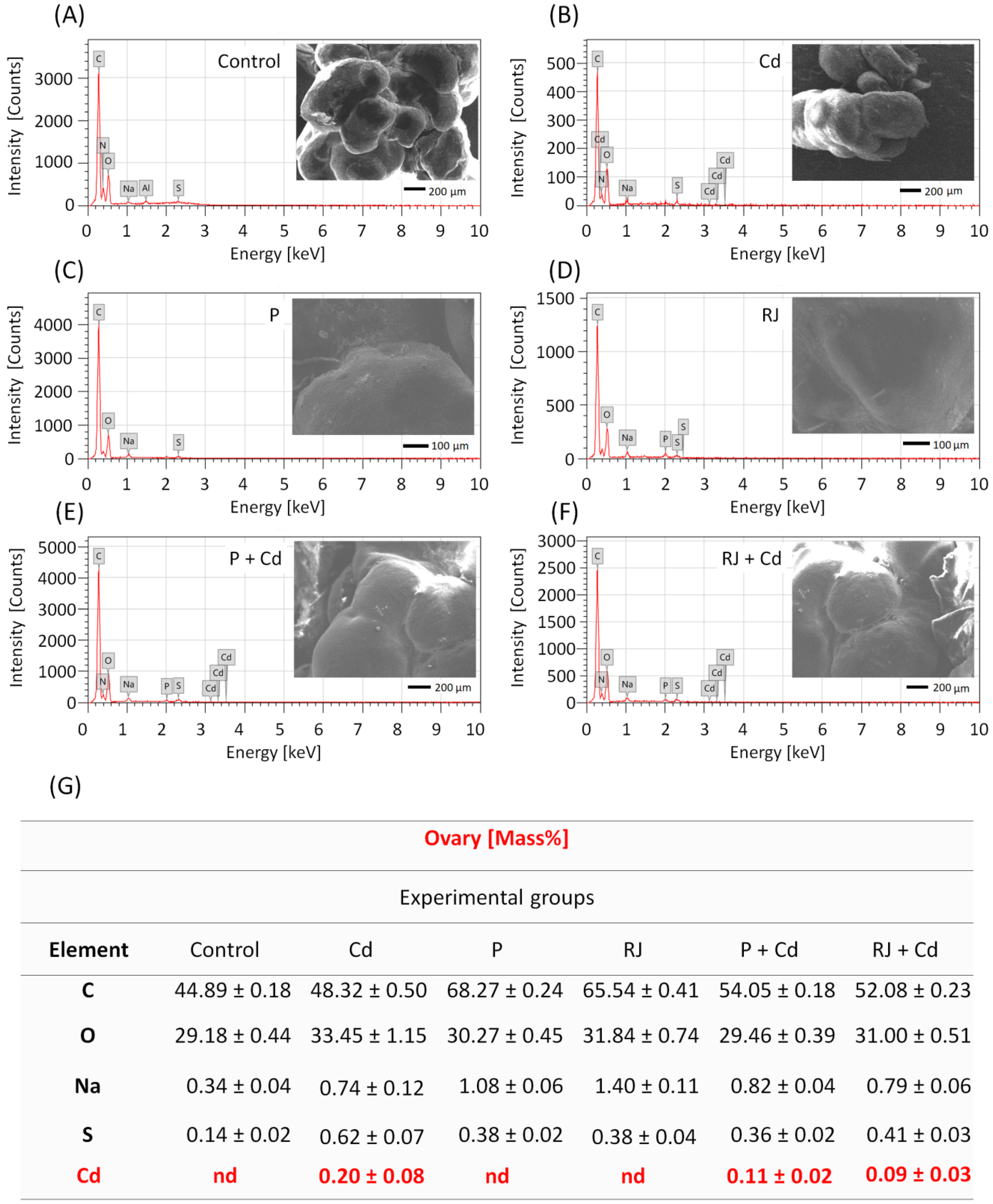
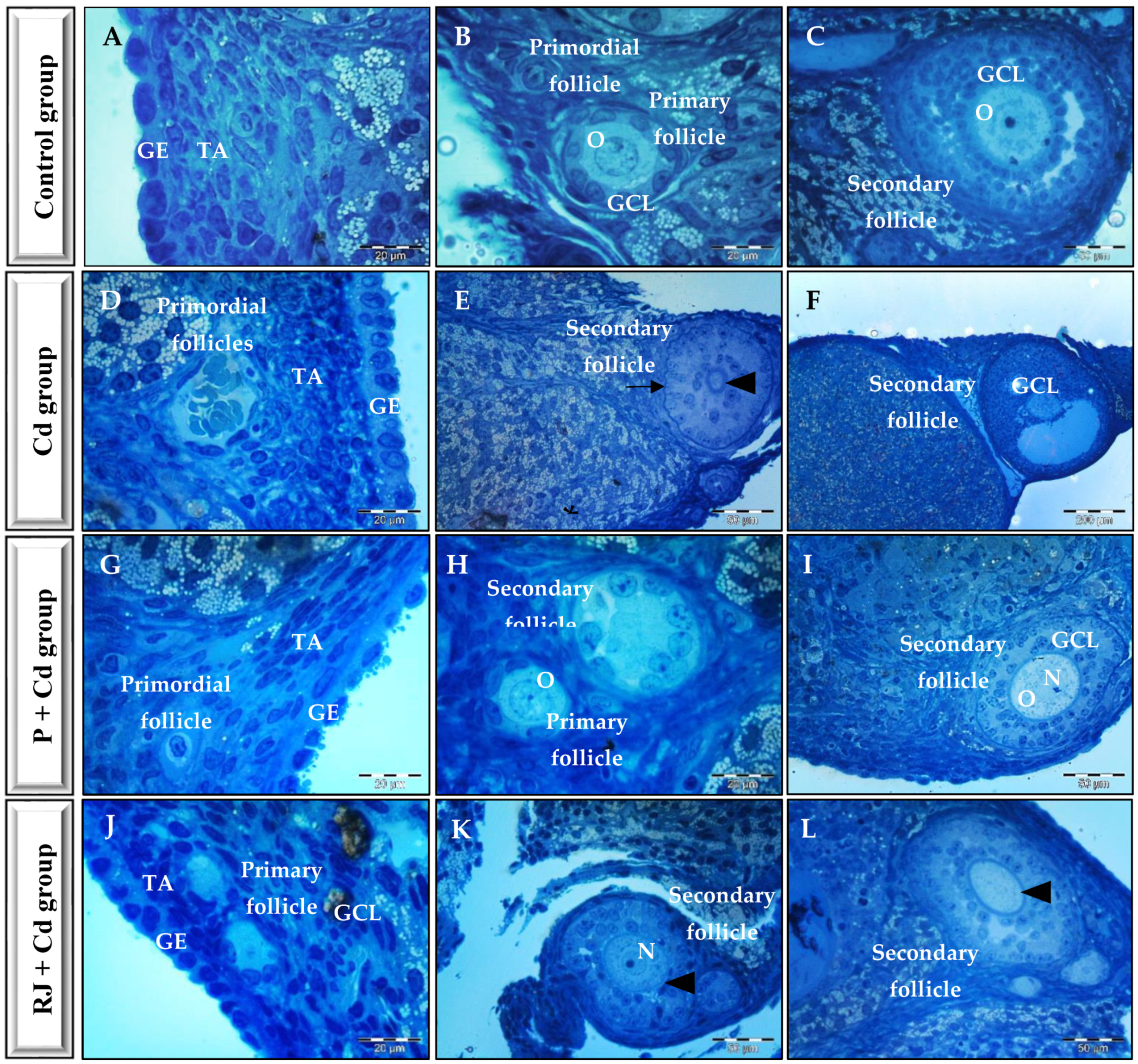

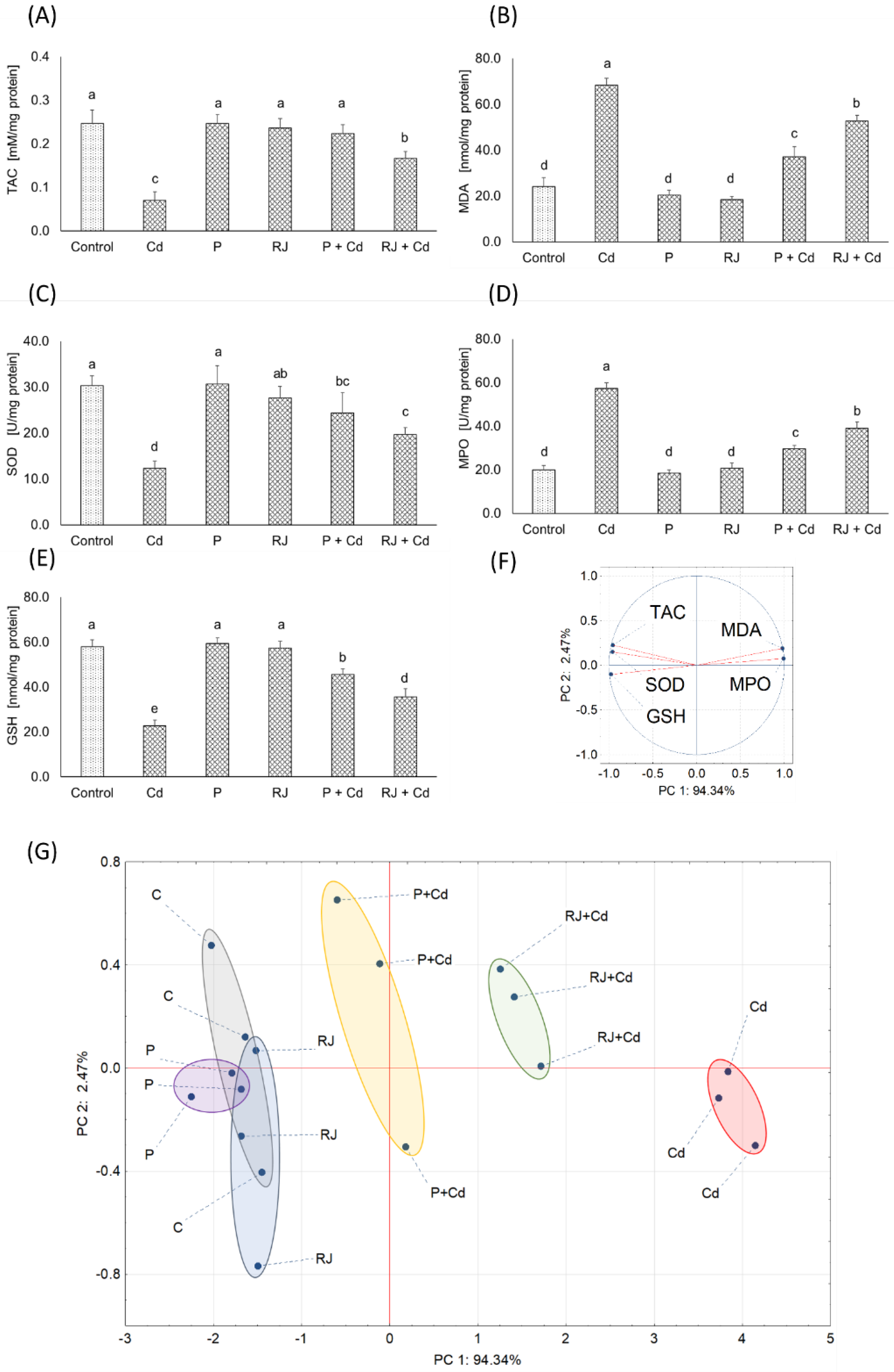
| No. | Compound | Rt | MW | MF | MS2 | Class of the Compounds | Reference |
|---|---|---|---|---|---|---|---|
| 1 | 10-Acetoxydecanoic acid 1 | 1.17 | 229.759 | C12H22O4 | 199.9730, 185.0170, 98.9600, 86.0030, 69.999 | Fatty acid | [40] |
| 2 | 3,11-Dihydroxydodecanoic acid 1 | 1.32 | 232.078 | C12H24O4 | 141.9810, 99.9910, 69.9010 | Fatty acid | [40] |
| 3 | Catechin 2 | 2.42 | 290.08 | C15H14O6 | 272.0930, 254.9760, 237.0960 | Flavonoid | [41] |
| 4 | Neovestitol 2 | 3.10 | 272.140 | C16H16O4 | 254.2770, 237.0920 | Flavonoid | [42,43] |
| 5 | Isocupressic acid 2 | 3.80 | 319.115 | C20H32O3 | 272.0480, 177.0170, | Fatty acid | [44] |
| 6 | 10-Hydroxy-2-decenoic acid 1 | 4.25 | 187.1300 | C10H18O3 | 169.0010, 152.8800, 141.9000, 138.0102, 125.3000, 112.0030, 87.000 | Fatty acid | [45] |
| 7 | Quercetin tetramethyl ether 2 | 5.91 | 358.290 | C19H18O7 | 313.1370, 151.2220 | Flavonoid | [46] |
| 8 | (2R,3R)-Pinobanksin 3-isobutyrate 2 | 6.41 | 328.210 | C19H20O5 | 251.0690, 175.0410, 157.0110, | Flavonoid | [47] |
| 9 | Maltulose 1,2 | 6.50 | 360.099 | C12H24O12 | 324.9800, 276.9570, 258.9660, 162.9560 | Carbohydrate | [48] |
| 10 | Tributyl phosphate 2 | 6.87 | 267.561 | C12H27O4P | 249.0670, 221.9830, 210.9860, 154.8940, 136.0840, 98.8430 | organophosphorus | https://bit.ly/3yDP42j (accessed on 12 November 2022) |
| 11 | (11S)-Hydroxydodecanoic acid 1 | 10.02 | 216.093 | C12H24O3 | 125.9520, 99.9920, 83.9820, 69.8470 | Fatty acid | [40] |
| 12 | Chlorogenic acid 2 | 10.50 | 354.377 | C16H18O9 | 175.0050, 163.1070 | Phenolic acid | [49] |
| 13 | 3,10-Dihydroxydecanoic acid 1 | 13.99 | 204.041 | C10H20O4 | 169.0100, 83.9380 | Fatty acid | [48] |
| 14 | 1,2-Benzenedicarboxylic acid, bis(2-methylpropyl) ester 1,2 | 14.88 | 279.010 | C16H22O4 | 232.9580, 223.0710, 219.0410, 204.9220, 201.0100, 172.9940, 166.9990, 148.9170 | Phthalate ester | https://bit.ly/3eFS8UC (accessed on 12 November 2022) |
| Group | No. of Cycles | Cycle Length | Days in Each Phase | |||
|---|---|---|---|---|---|---|
| Proestrus | Estrus | Metestrus | Diestrus | |||
| Control | 3.33 ± 0.47 | 4.28 ± 0.55 | 1.25 ± 0.43 | 1.5 ± 0.50 | 0.75 ± 0.25 | 2.67 ± 0.47 |
| P | 3 ± 0.81 b | 5.05 ± 0.34 * | 1 a,b | 1.33 ± 0.47 b | 0.83 ± 0.24 | 2.17 ± 0.27 *,a,b |
| RJ | 3.67 ± 0.47 | 4.5 a,d | 1 a | 1.5 ± 0.41 | 0.67 ± 0.24 | 2.17 ± 0.24 *,a |
| Cd | 2.67 ± 0.47 * | 5.22 ± 0.39 * | 1.67 ± 0.47 *,c | 1.33 ± 0.47 b | 0.80 ± 0.24 | 1.67 ± 0.47 *,c |
| P + Cd | 2.33 ± 0.47 *,c | 5.11 ± 0.63 * | 1.5 ± 0.41 c | 1.83 ± 0.62 a,c | 0.83 ± 0.24 | 1.83 ± 0.24 *,c |
| RJ + Cd | 3.33 ± 0.94 | 4.16 ± 0.24 a,e | 1.16 ± 0.24 a | 1.33 ± 0.58 | 0.67 ± 0.24 | 2.33 ± 0.47 a |
Disclaimer/Publisher’s Note: The statements, opinions and data contained in all publications are solely those of the individual author(s) and contributor(s) and not of MDPI and/or the editor(s). MDPI and/or the editor(s) disclaim responsibility for any injury to people or property resulting from any ideas, methods, instructions or products referred to in the content. |
© 2022 by the authors. Licensee MDPI, Basel, Switzerland. This article is an open access article distributed under the terms and conditions of the Creative Commons Attribution (CC BY) license (https://creativecommons.org/licenses/by/4.0/).
Share and Cite
Amr, A.; Abd El-Wahed, A.; El-Seedi, H.R.; Khalifa, S.A.M.; Augustyniak, M.; El-Samad, L.M.; Abdel Karim, A.E.; El Wakil, A. UPLC-MS/MS Analysis of Naturally Derived Apis mellifera Products and Their Promising Effects against Cadmium-Induced Adverse Effects in Female Rats. Nutrients 2023, 15, 119. https://doi.org/10.3390/nu15010119
Amr A, Abd El-Wahed A, El-Seedi HR, Khalifa SAM, Augustyniak M, El-Samad LM, Abdel Karim AE, El Wakil A. UPLC-MS/MS Analysis of Naturally Derived Apis mellifera Products and Their Promising Effects against Cadmium-Induced Adverse Effects in Female Rats. Nutrients. 2023; 15(1):119. https://doi.org/10.3390/nu15010119
Chicago/Turabian StyleAmr, Alaa, Aida Abd El-Wahed, Hesham R. El-Seedi, Shaden A. M. Khalifa, Maria Augustyniak, Lamia M. El-Samad, Ahmed E. Abdel Karim, and Abeer El Wakil. 2023. "UPLC-MS/MS Analysis of Naturally Derived Apis mellifera Products and Their Promising Effects against Cadmium-Induced Adverse Effects in Female Rats" Nutrients 15, no. 1: 119. https://doi.org/10.3390/nu15010119
APA StyleAmr, A., Abd El-Wahed, A., El-Seedi, H. R., Khalifa, S. A. M., Augustyniak, M., El-Samad, L. M., Abdel Karim, A. E., & El Wakil, A. (2023). UPLC-MS/MS Analysis of Naturally Derived Apis mellifera Products and Their Promising Effects against Cadmium-Induced Adverse Effects in Female Rats. Nutrients, 15(1), 119. https://doi.org/10.3390/nu15010119








